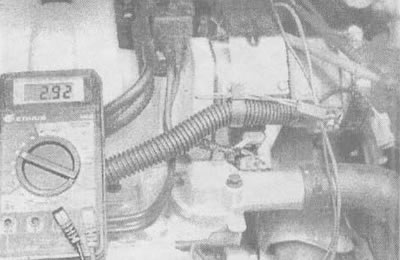General description
95. The intake air temperature sensor is located inside the air intake directly behind the air filter housing. This sensor works like a resistor, the resistance of which changes along with fluctuations in the temperature of the air entering the engine. At low air temperatures, the resistance will be large (for example, at -5°C the resistance of the sensor is 100.000 ohms; as the temperature rises, the resistance decreases (so, at 131°C, the resistance drops to 70 ohms). The PCM supplies the IAT sensor with a signal voltage of approximately 5 volts. This voltage changes according to the temperature of the air entering the engine. If the air is cold, the signal voltage will be high, and vice versa, if the air temperature is high, the voltage will drop.
Examination
96. To test the IAT sensor, disconnect the two-pin electrical connector from it and turn on the ignition, but do not start the engine.
97. Measure voltage (signal) on contact "A" (see illustration). The voltmeter should show a value close to 5 V.

4.97. Measure the signal voltage at the sensor by touching the output of the voltmeter to its contact "A" (orange wire)
98. If the signal voltage differs from the specified value, take the PCM to a repair shop.
99. Measure the resistance at the sensor contacts (see illustration). If the air temperature is low, the sensor resistance should be high. Then start the engine and let it idle (cold). After waiting until it warms up to normal operating temperature, turn off the ignition, disconnect the IAT sensor and measure the voltage at its contacts. When the air temperature is high, the resistance of the sensor should be small. If the resistance of the sensor has a different temperature dependence, replace the sensor with a new one.

4.99. Example: ambient temperature is approximately 5°C; ohmmeter shows a resistance of 2.92 ohms (on a scale of 2K)
Note. As "masses" contact can also be used "IN" (black and white wire) at the sensor connector.
